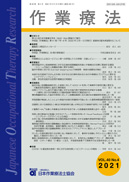Volume 40, Issue 5
Displaying 1-19 of 19 articles from this issue
- |<
- <
- 1
- >
- >|
FOREWORD
-
Article type: FOREWORD
2021Volume 40Issue 5 Pages 551
Published: October 15, 2021
Released on J-STAGE: October 15, 2021
Download PDF (873K)
ORIGINAL ARTICLES
-
Article type: ORIGINAL ARTICLES
2021Volume 40Issue 5 Pages 553-561
Published: October 15, 2021
Released on J-STAGE: October 15, 2021
Download PDF (1312K) -
Article type: ORIGINAL ARTICLES
2021Volume 40Issue 5 Pages 562-571
Published: October 15, 2021
Released on J-STAGE: October 15, 2021
Download PDF (1389K) -
Article type: ORIGINAL ARTICLES
2021Volume 40Issue 5 Pages 572-580
Published: October 15, 2021
Released on J-STAGE: October 15, 2021
Download PDF (1470K) -
Article type: ORIGINAL ARTICLES
2021Volume 40Issue 5 Pages 581-590
Published: October 15, 2021
Released on J-STAGE: October 15, 2021
Download PDF (1750K) -
Article type: ORIGINAL ARTICLES
2021Volume 40Issue 5 Pages 591-597
Published: October 15, 2021
Released on J-STAGE: October 15, 2021
Download PDF (1361K) -
Article type: ORIGINAL ARTICLES
2021Volume 40Issue 5 Pages 598-607
Published: October 15, 2021
Released on J-STAGE: October 15, 2021
Download PDF (1375K) -
Article type: ORIGINAL ARTICLES
2021Volume 40Issue 5 Pages 608-615
Published: October 15, 2021
Released on J-STAGE: October 15, 2021
Download PDF (1445K) -
Article type: ORIGINAL ARTICLES
2021Volume 40Issue 5 Pages 616-624
Published: October 15, 2021
Released on J-STAGE: October 15, 2021
Download PDF (1551K)
PRACTICAL REPORTS
-
Article type: PRACTICAL REPORTS
2021Volume 40Issue 5 Pages 625-632
Published: October 15, 2021
Released on J-STAGE: October 15, 2021
Download PDF (1424K) -
Article type: PRACTICAL REPORTS
2021Volume 40Issue 5 Pages 633-640
Published: October 15, 2021
Released on J-STAGE: October 15, 2021
Download PDF (1606K) -
Article type: PRACTICAL REPORTS
2021Volume 40Issue 5 Pages 641-648
Published: October 15, 2021
Released on J-STAGE: October 15, 2021
Download PDF (1905K) -
Article type: PRACTICAL REPORTS
2021Volume 40Issue 5 Pages 649-657
Published: October 15, 2021
Released on J-STAGE: October 15, 2021
Download PDF (2030K) -
Article type: PRACTICAL REPORTS
2021Volume 40Issue 5 Pages 658-664
Published: October 15, 2021
Released on J-STAGE: October 15, 2021
Download PDF (1284K) -
Article type: PRACTICAL REPORTS
2021Volume 40Issue 5 Pages 665-673
Published: October 15, 2021
Released on J-STAGE: October 15, 2021
Download PDF (1779K) -
Article type: PRACTICAL REPORTS
2021Volume 40Issue 5 Pages 674-682
Published: October 15, 2021
Released on J-STAGE: October 15, 2021
Download PDF (1622K) -
Article type: PRACTICAL REPORTS
2021Volume 40Issue 5 Pages 683-690
Published: October 15, 2021
Released on J-STAGE: October 15, 2021
Download PDF (1664K) -
Article type: PRACTICAL REPORTS
2021Volume 40Issue 5 Pages 691-698
Published: October 15, 2021
Released on J-STAGE: October 15, 2021
Download PDF (1588K) -
Article type: PRACTICAL REPORTS
2021Volume 40Issue 5 Pages 699-706
Published: October 15, 2021
Released on J-STAGE: October 15, 2021
Download PDF (1435K)
- |<
- <
- 1
- >
- >|
